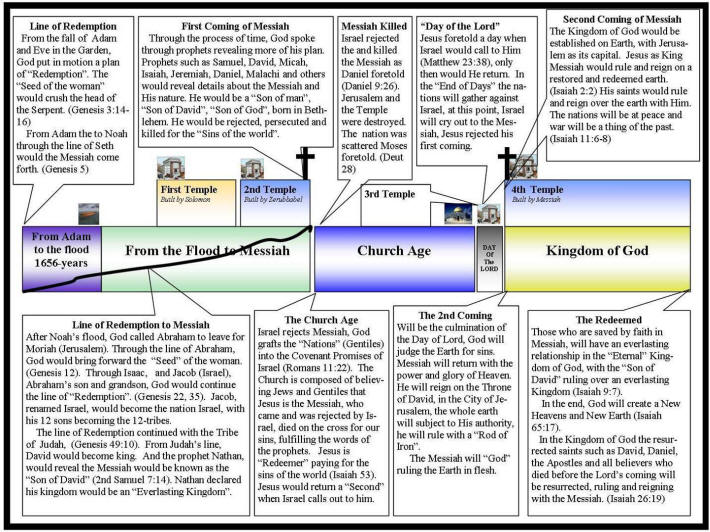
3. Isaiah Chapters 1-5: The Kingdom of God
4. Isaiah Chapters 6-10: God with us
5. Isaiah Chapters 11-26: The Rod of Jesse
6. Isaiah Chapters 27-32 The Righteous King
7. Isaiah Chapters 33-39 The Righteous King
8. Isaiah Chapters 40-43 The Servant of the Lord
9. Isaiah Chapters 44-45 The Servant of the Lord
10. Isaiah Chapters 46-48 The Redeemer and Savior
11. Isaiah Chapters 49-52: The Suffering Servant
1. Introduction to the book of Isaiah
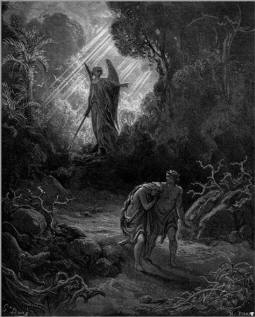 In
the Garden of Eden, Adam and Eve had fellowship and communed with Almighty
God who walked the Garden in the cool of the day with His creation. Adam
and Eve were created in the image of God and were given dominion over God’s
creation, they were told to multiply and subdue the earth (Genesis 1:28).
In
the Garden of Eden, Adam and Eve had fellowship and communed with Almighty
God who walked the Garden in the cool of the day with His creation. Adam
and Eve were created in the image of God and were given dominion over God’s
creation, they were told to multiply and subdue the earth (Genesis 1:28).
This all changed at the
fall in
Following the fall, The Lord confronted Adam and Eve as well as the Serpent.
God declared the consequences of sin, how death and suffering would result in rejecting the Word of God(Genesis 3:16-19). God also promised a coming victory and redemption over the work of the Serpent, by the woman’s “seed” that would crush the head the serpent.
15 And I will put enmity
Between you and the woman, And between your seed and her Seed; He shall
bruise your head, And you shall bruise His heel."
The “seed of the woman
is the promise redemption which would one day restore man, and give him
victory over the work of the serpent. This special or anointed person is
known in Hebrew as the Messiah or Christ in Greek. The plan of Redemption
is first declared here in Genesis and continues from Genesis chapter 3 until
Revelation chapter 20, when finally in
The Bible and Messiah
![]()
The Bible is God’s revelation to man, His “fallen” creation, of His Truth, Love and plan of redemption. Through the prophets God revealed to the descendents of Adam and Eve the “Reality” of their circumstances. The idea we live in a fallen world is a concept which is anathema to the secular world. The only way we can understand who we are , where we are going and the purpose of our being is if God chooses to reveal it to us.
The process of revelation God chooses to use is through individuals known as prophets, God’s spokesman who reveal God’s WORD to mankind. Through the first five books of the Bible, God used Moses to reveal the Creation and fall of mankind. God continued reveal his plan through those who followed Moses; including Joshua, Samuel, David, Elijah, Isaiah, Jeremiah, Ezekiel and others. These men were inspired by the Holy Spirit to reveal the Word of God, their revelations included history and events in the process of redemption.
This is key point to remember, though the Bible speaks of other topics and histories wrapped within all these topics is the focus of Redemption through Messiah. Jesus make this point clear when addressing the questioned his authority to heal lame man on the Sabbath. Jesus declares;
39 "You search the
Scriptures, for in them you think you have eternal life; and these are they
which testify of Me. 40 "But you are not willing to come to Me that you may
have life
The focus of the whole Bible is Jesus the Messiah who redeems lost humanity from their sin. Jesus is the focus of scripture both Old and New Testament. No other book of the Bible is more clear on this then the book of Isaiah. In the book of Isaiah we are presented with two pictures of the Messiah.

The Messiah
The term Messiah; xyXm Mashiyach (maw-shee'-akh); is translated into Greek as Christos, the word means anointed or anointed one. The origin of Hebrew word is derived from the Hebrew term Mashach meaning “to spread or smear”. The process of anointing someone for service involved smearing oil on them such as happened to King Saul (I Samuel 10:1) and Aaaron (Exodus 29:29), when they were chosen by God. Therefore the term “Messiah” has been applied to both kings and priests. However ultimately, the term was to be applied to an everlasting king, who would rule over an everlasting kingdom, this person came to be known in Jewish theology as “The Messiah”, the who would restore and rescue Israel from their oppressors.
Of all the prophets in the Old Testament, Isaiah more then any other gave us the most detailed understanding of this person known as “The Messiah”. Isaiah like other prophets builds on the revelations of previous prophets, his words in the Book of Isaiah gives us a much greater understanding of God’s plan of Redemption. He reveals the very character and nature of Messiah, how he would first come as a “Servant” and be rejected by his own people, to pay for the sin of the world (Isaiah 53). Isaiah also reveals this same rejected “Servant” would one day rule over the earth as God and King.
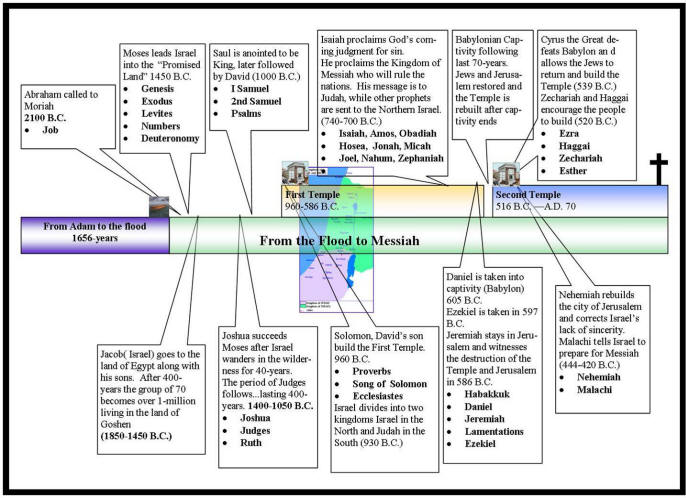
The timeline of Isaiah
To better understand Isaiah its important to understand the context of the time period Isaiah lived, and how he related to the prophets and events before him. God’s plan of redemption began in the Garden of Eden after the fall. So the first period of time in the Bible covers the period before the flood.
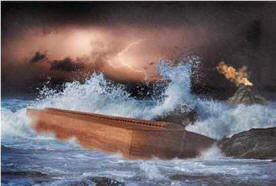 1.
Antediluvian period (Before the flood)(4000 B.C-2400 B.C.):
This period begins with Adam and ends with Noah and the flood. Biblically
this period covers about 1656-years and can be traced from Adam to Noah,
through the line of Noah, from his son Seth (Genesis 5), God would continue
his promise of the “Seed” of the woman who would crush the “Head” of the
serpent.
1.
Antediluvian period (Before the flood)(4000 B.C-2400 B.C.):
This period begins with Adam and ends with Noah and the flood. Biblically
this period covers about 1656-years and can be traced from Adam to Noah,
through the line of Noah, from his son Seth (Genesis 5), God would continue
his promise of the “Seed” of the woman who would crush the “Head” of the
serpent.
2. God calls Abraham: (2100 B.C.-1850 B.C.) About 400-years after the flood, God called Abraham to leave the land of Babylon and move the land of Moriah (Jerusalem). There God continued his plan of redemption through the line of Abraham (Genesis 12). This promise of redemption is then continued with Abraham’s son Isaac (Genesis 22) and Isaac’s son Jacob, later renamed Israel (Genesis 35).
3. In the Land of Egypt: (1800-1450 B.C.) Jacob and his descendents went to Egypt, as the result of famine in Canaan. They numbered seventy when they entered Egypt, 400-years later their numbers grow to over 1-million men. Through Moses, a descendent of Jacob God would lead Israel out of Egypt back to the land promised to Abraham 600-years earlier.
4. Moses leads Israel out of Egypt: (1450 B.C.-1400 B.C.) Moses leads Israel out of Egypt through signs and wonders on the land of Egypt. God establishes the Mosaic Covenant, God reveals to Moses the events at the creation and the fall, Moses records these events in Genesis. God establishes the Tabernacle and the Aaron priesthood. Israel rebels against God, and as a result wanders in the wilderness of Sinai for 40-years.
5. Joshua Israel into the “Promised Land”: (1400-1050 B.C.) Joshua continues where Moses left off. Moses dies outside of the land of Promise. Joshua then leads the nation into their land and takes possession of the land. Through a 300-year period God used 12-judges to judge the land, including Samson, Gideon and others.
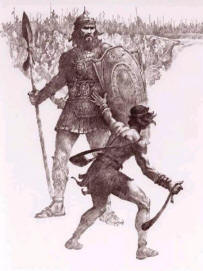 6.
Israel wants a King: (1050-930 B.C.):
Israel tired of her
judges who were sent to her in her times of trouble resulting from their
disobedience. They demanded a king like the other nations. God had Samuel
anoint Saul as their first King in 1050 B.C. Following Saul, David was
anointed after Saul disobeyed God’s commands. Through Nathan, God promised
that the plan of redemption would continued in the line of David (2 Samuel
7:16). The “Seed” of the woman would be a “son of David”.
6.
Israel wants a King: (1050-930 B.C.):
Israel tired of her
judges who were sent to her in her times of trouble resulting from their
disobedience. They demanded a king like the other nations. God had Samuel
anoint Saul as their first King in 1050 B.C. Following Saul, David was
anointed after Saul disobeyed God’s commands. Through Nathan, God promised
that the plan of redemption would continued in the line of David (2 Samuel
7:16). The “Seed” of the woman would be a “son of David”.
7. The Divided Kingdom (930 B.C. -722 B.C.) Following David, his son Solomon would build the First Temple on the Temple Mount, Mount Moriah, the same place where Abraham brought Isaac 1000-years earlier. The Temple was consecrated by God’s presence (I Kings 8). God promised to maintain His presence if Israel stayed obedient. Israel began to turn away from the Lord during the time of Solomon. God divided the Kingdom into a northern Kingdom known as Israel and southern Kingdom known as Judah. In their disobedience God brought the mighty empire of Assyria to judge Israel. Israel was taken captive in 722 B.C... Judah to the south was spared an Assyrian victory because Hezekiah prayed to the Lord for deliverance. (Isaiah 37)
Isaiah lived about 70-years before the days of Jeremiah, Ezekiel and Daniel. He was a close confident of Hezekiah, in the same way Jeremiah was a friend to Hezekiah’s grandson Josiah.
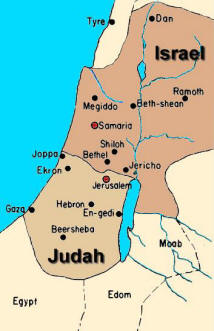 Isaiah
in the Divided Kingdom
Isaiah
in the Divided Kingdom
Isaiah’s main ministry was to the Kingdom of Judah the southern of Israel, Micah was another prophet to Judah. While the prophets Hosea, Amos proclaimed warnings on the northern Kingdom of Israel. Jonah during Isaiah’s day would have visited the capital of the world’s most powerful kingdom, Assyria and proclaimed God’s judgment unless they repent. The prophets to Israel and Judah urged repentance and judgment.
Within the context of their words, were revelations about the coming redemption through the work of Messiah. Most of the prophets the major and minor prophets of the Old Testament followed the establishment of the First Temple.
8. Assyrian and Babylonian conquest (722 B.C.-586 B.C.) Nineveh was the capital of Assyria, while Babylon was the capitol of Babylon. Both nations would play a significant role in Israel and Judah’s history. Assyria was used to judge Israel, while Babylon was used to judge Judah. Babylon was south of Assyria, and would one day defeat the more powerful neighbor to the north. In the context of these events the prophets of Israel an Judah foretold the day’s of Messiah who would establish an eternal Kingdom which would never end.
In 586 B.C., after the warnings of Jeremiah and Ezekiel God destroyed the city of Jerusalem and the Temple built by Solomon, because of the people continued idolatry and sin. Israel was desolate for 70-years while the descendents of Judah were captive in the land of Babylon.
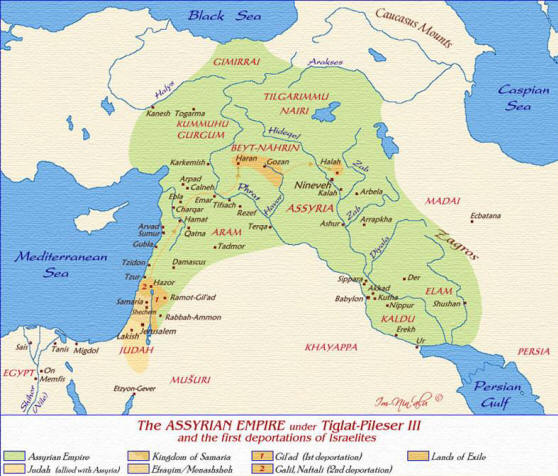
9. Judah restored to the land of Israel (539 B.C. 70 A.D.): In 539 B.C., Cyrus as foretold by Isaiah conquered the of Babylon and established the Persian Kingdom (Iran). Cyrus allowed the Jews to return and begin construction of the 2nd Temple on Mount Moriah. The Temple was completed in 516 B.C. This began the Second Temple period, contemporizes of the Second Temple in the Old Testament, included Esther, Ezra, Nehemiah, Zechariah, Haggai and Malachi. The Second Temple would continue until 37-years after the death of Messiah as foretold in the book of Daniel (Daniel 9:26).
Date and Authorship of Isaiah
The authorship of Isaiah is a major issue of contention among Bible scholars, separated by two camps. Those who argue for a single author “Isaiah” who ministered in Judah from 740 to about 700 B.C., and those who say more then one person wrote the book.
The words contained within the book of Isaiah are amazing in their scope and fulfillment. Many critics of the Bible are unable to accept the Bible as a supernatural book. As a result critics of the Bible have decided that Isaiah could not have been written by one man but must have included a “Second” or even “Third” Isaiah.
Starting with the
historical criticism movement, liberal bible scholars agree the material in
chapters 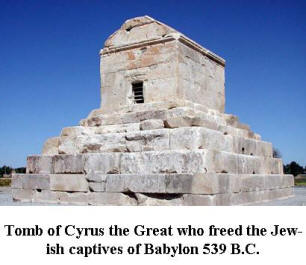 written
by Isaiah, since it refers to events surrounding the Assyrian threat to
Judah and Israel. However, they insist the material in chapters 40 to 66
refer to the Babylonian captivity and Cyrus the Great (Isaiah 45:1), taking
place 200-years after Isaiah.
written
by Isaiah, since it refers to events surrounding the Assyrian threat to
Judah and Israel. However, they insist the material in chapters 40 to 66
refer to the Babylonian captivity and Cyrus the Great (Isaiah 45:1), taking
place 200-years after Isaiah.
28 Who says of Cyrus, 'He
is My shepherd, And he shall perform all My pleasure, Saying to Jerusalem,
"You shall be built," And to the temple, "Your foundation shall be laid." '
Therefore they argue these could not be written by Isaiah since they are not within his time period. They say another person; a “Second” Isaiah must have been the author of these chapters. Additionally they point to styles of writing; tone and language differences between these two sections of Isaiah as further evidence.
The underlying assumption of the historical criticism movement is to reject the “supernatural nature” of scripture. If something appears to be supernatural then there must by for explanation to the event. There arguments fall apart once someone really understands nature of Isaiah’s revelation. Seven hundred years before the birth of Jesus, Isaiah describes Israel’s rejection of the “Servant” as an offering for sin (Isaiah 53). So his prophecies regarding the Messiah were written about over 700-years before the event. Isaiah also describes the gathering of the nation of Israel and Judah from the nation, before they were dispersed in the “last days” (Isaiah 11), Isaiah is looking forward to events 2600-years in the future. Therefore calling on Cyrus two hundred years before his arrival on the scene is just one of many supernatural evidences of Isaiah.
The unity of the
book of Isaiah can also be demonstrated with phrases used throughout the
book both in chapters
Little is known about Isaiah apart from what is revealed in the book. We know he was married to a “prophetess” (Isaiah 8:3) he had two children. He two children were given symbolic names to demonstrate the judgment of God against the land. The level of his writing indicates he was a learned man from a upper class background. He was called to the ministry in the year King Uzziah died (Isaiah 6:1) about 740 B.C. He prophesied about 40-years in the land of Judah.
Evidence of Isaiah
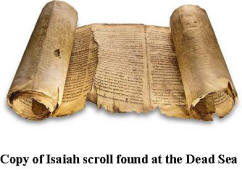 The
evidence for the integrity for Isaiah can be found both in manuscript and
The
evidence for the integrity for Isaiah can be found both in manuscript and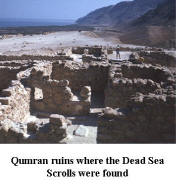 archeology. First the Dead Sea scrolls confirm the manuscript transmission
of Isaiah. Prior to the Dead Sea discovery many questioned whether the book
of Isaiah was essentially the same as was before the time of Christ. Then
in 1948, with the discovery of manuscripts at the Dead Sea in the city of
Qumran, two copies of Isaiah were discovered which predated earlier Hebrew
manuscripts by over 1000-years.
archeology. First the Dead Sea scrolls confirm the manuscript transmission
of Isaiah. Prior to the Dead Sea discovery many questioned whether the book
of Isaiah was essentially the same as was before the time of Christ. Then
in 1948, with the discovery of manuscripts at the Dead Sea in the city of
Qumran, two copies of Isaiah were discovered which predated earlier Hebrew
manuscripts by over 1000-years.
Hezekiah’s Tunnel
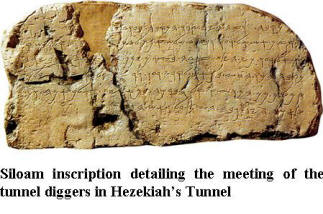 The
archeological evidence also validates Isaiah. The Assyrian were invading
the land in Isaiah’s day during the reign of Hezekiah. In preparation of
the invasion Hezekiah had a tunnel carved underneath the walls of Jerusalem
to guarantee the water supply to Jerusalem if Assyria were to besiege the
city.
The
archeological evidence also validates Isaiah. The Assyrian were invading
the land in Isaiah’s day during the reign of Hezekiah. In preparation of
the invasion Hezekiah had a tunnel carved underneath the walls of Jerusalem
to guarantee the water supply to Jerusalem if Assyria were to besiege the
city.
30 This same Hezekiah
also stopped the water outlet of Upper Gihon, and brought the water by
tunnel to the west side of the City of David. Hezekiah prospered in all his
works.
The Hezekiah Tunnel was discovered along with an engraving in the tunnel describing what happened when the two groups of diggers met.
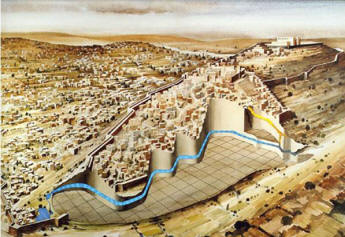 1.
[. . .] the tunneling; and this was how the tunneling was completed: as [the
stonecutters wielded]
1.
[. . .] the tunneling; and this was how the tunneling was completed: as [the
stonecutters wielded]
2. their picks, each crew toward the other, and while there were still three cubits to g[o], the voices of the men calling
3. each other [could be hear]d, since there was an increase (in sound) on the right [and lef]t. The day the
4. breach was made, the stonecutters hacked toward each other, pick against pick, and the water
5. flowed from the source to the pool [twel]ve hundred cubits, even though the
6. height of the rock above the heads of the stonecutte[rs] was a hundred cubits!
Sennacherib Prism
Evidence for the events of Isaiah can also be found in the Assyrian records. King Sennacherib (700 B.C.) who conquered the nations surrounding Judah was not able to conquer Jerusalem as described in the book of Isaiah (Isaiah 37). He attempt to conquer Jerusalem is recorded in the stone document known as the Sennacherib Prism which was discovered in 1830 in the capitol of Assyria, Nineveh.
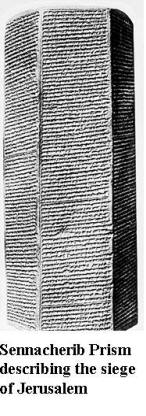 18As
for Hezekiah the Judahite, 19who
did not submit to my yoke: forty-six of his strong, walled cities, as well
as 20the
small towns in their area, 21which
were without number, by leveling with battering-rams 22and
by bringing up siege-engines, and by attacking and storming on foot, 23by
mines, tunnels, and breeches,
18As
for Hezekiah the Judahite, 19who
did not submit to my yoke: forty-six of his strong, walled cities, as well
as 20the
small towns in their area, 21which
were without number, by leveling with battering-rams 22and
by bringing up siege-engines, and by attacking and storming on foot, 23by
mines, tunnels, and breeches,
